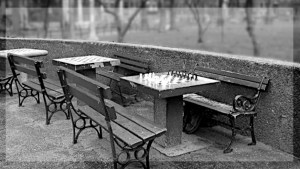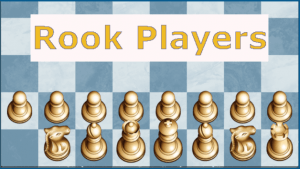|
In the last quarter of the 19th century several Berlin cafés stood out as places where chess and other games could be played. It was at theses places where the great German players who would lead the chess world into the 20th century learned their craft.
Three of these were the cafés Kaiserhof, Royal and Bauer.
 Else Lasker-Schüler in the Café Westens Else Lasker-Schüler in the Café Westens In the book "Berlin Metropolis: Jews and the New Culture, 1890-1918," the author, Emily Bilski, talking about the "Café Culture in Berlin," wrote:
"Many of the letters, postcards, and telegrams that Lasker-Schüler included in 'My Heart' begin with the sentence, 'I went to the café.'"
While Else Lasker-Schüler, the famous bohemian playwright/poetess who was married to Dr. Jonathan Berthold Lasker (Emanuel's older brother and a chess master in his own right) for almost a decade (1894-1903), usually went to the Café Westens (No.18/19 Kurfürstendamm). Most of these places shared many commonalities. Most subscribed to a multitude of newspapers and even employed a "newspaper waiter." Most "offered free chessboards and billiard tables, and in the ice-cold Berlin winters guests could save a small fortune by not having to pay heating costs at home." The author describes early cafés as dens of iniquity habitated by rough men and loose women. Lasker-Schüler wrote "Secretly we all think of the café as the devil, but without the devil there is nothing."
Café Royal -
The corner of Unter den Linden and Charlottenstrasse
"Do you see that building at the corner of the Charlottenstrasse ? That is the Cafe Royal! Let us turn in there, I beg ; I cannot pass without a glance inside. You do not wish to? Be it so ; but you must humour me when we return this way. Opposite you, at an oblique angle, is the Hotel de Rome, and there, to the left, is the Hotel de Petersbourg, the two most important hotels here." -Heinrich Heine "Heine in Art and Letters," circa 1837
The building that housed the Café Royal is today the site of the Deutch Guggenheim bank/museum
There's not a lot of information about this café.
The "Schach-jahrbuch" in 1894 informs us:
1884 (January 18): concluded the tournament at the Café Royal in Berlin. The four hard-won Prizes: 1 Hermann von Gottschall (son of the poet and writer Rudolf von Gottschall in Leipzig, born October 16, 1862 in Posen), 2nd Schallopp; 3 Max Harmonist (ballet dancer in Berlin), 4th B. Lasker. [Hermann von Gottschall wrote the wonderful book, "Adolf Anderssen, Altmeister deutscher Schachspielkunst"]
There were chess tournaments held there as late as 1897 and several known players hung out there over the years. Besides some casual mentions in other various chess magazines of that time, the "BCM" of January 1888 does tell us:
Herr Trobach, one of Berlin's strongest players, died suddenly a short time ago of disease of the heart. His state of health had long obliged him to abandon tourney and match games, but every afternoon he was to be found at the Café Royal, where he was the soul of the circle of strong players regularly assembling, and such names as Briining, Caro, Seufert, and Harmonist are to be reckoned among his pupils. Herr Trobach disliked publicity, and took down very few of his games, for which reason his name outside Berlin was but little known.
Below is one of the few published games by Adalbert Trobach. He lost to Emil Schallopp in 1886.
Emanuel Lasker, born in late in December of 1868 wasn't quite 20 when he felt strong enough to participate in the Berlin Chess Society tournaments. By 1891, he was giving simuls. Below is a game from a simul given at the Café Royal in 1891.
Café Kaiserhof -
 Café Kaiserhof , located at Zietenplatz und Wilhelmplatz in the Hotel KaiserhofPostcard from the year 1900 Café Kaiserhof , located at Zietenplatz und Wilhelmplatz in the Hotel KaiserhofPostcard from the year 1900
 An 1888 advertisement for the Kaiserhof An 1888 advertisement for the Kaiserhof While the Kaiserhof has been mentioned as where Max Harmonist started playing in the early 1880s, other names asscociated with that café as Tarrasch, Berthold Lasker, Curt von Bardeleben, Wilhelm Cohn and of course Emanuel Lasker.
Some casual mentions of the Kaiserhof appeared in various periodicals:
"American Chess Monthly," June 1892
His [Laker's] name was first heard of in 1889, when in June of that year he carried off the first prize in a tounament held at Kaiserhof of Berlin, without losing a single game.
"American Chess Magazine," June 1897
Herr Mieses defeated Herr Caro, a local expert, in a match at the Kaiserhof, Berlin, by a score of 4 to 3.
"Literary Digest," 1897
On August 16 last, Lasker gave the odds of a Knight to a comparatively strong antagonist in the Kaiserhof Café, Berlin.
A game played at the Café Kaiserhof in 1877-
Café Bauer -
 Café Bauer on the corner of Friedrichstrasse and Unter den Linden Café Bauer on the corner of Friedrichstrasse and Unter den Linden
 Inside the Café Bauer Inside the Café Bauer
"New York Times," Feb. 14, 1884
Berlin's Tower of Babel
The Tower of Babel, with its confusion of tongues, has found a modern rival in the recently opened reading-room of the magnificent café Bauer, in Berlin, where the representatives of nearly every nationality on the globe have established a rendezvous, and where no less than 700 journals, in 18 different languages, including Turkish, Japanese, and Chinese, may be read.
While the café of choice in the last quarter of the 19th century in Berlin was the Kaiserhof, the Bauer is also mentioned. But when the Kaiserhof closed in 1906, the players gravitated to the Cafe Bauer in droves.
According to Kurt Richter (who would have arrived on the scene after WWI):
"In addition, however, there was that time in Berlin a number of chess cafes in areas where there was a daily traffic. The most significant in the period before World War undoubtedly was a Café Bauer Unter der Linden. Met there all chess players of the city, many masters, good and bad players."
"The most striking figure among the visitors of the cafe was without doubt master Richard Teichmann for his consistent tournament success (5th place) and 'Richard V.' mentioned. He was a giant in stature and looks more like a boxer than a chess master. He had in his youth due to a careless playmate lost an eye, but did not prevent him to be a shrewd player. . . About a player contnuing in a hopeless situation, he used to say: 'He has unlimited confidence in the inability of his opponent!'"
Richter also wrote in the "Berliner Schachverband,"
"An original personality who frequented the Café Bauer, was also Champion v. Bardeleben. His main fault was that he was too lazy to make money, so he had something rare. He came from wealthy family, but did not care about him. But once he inherited a large sum that evaporated but with some 'good friends' very quickly."
Edward Lasker wrote in "Chess Secrets I Learned From The Masters" (1951),
"One master on whose presence at the Café Bauer I could unfailingly count any evening, was Kurt Von Bardeleben."
An interview with Edward Lasker by J.E. Pinto appeared in the "American Go Magazine," June 1981 in which Lasker told how he first learned the game of Go:
"Then one day at the café in Berlin where the Chessplayers used to gather in the afternoon my friend Max Lange and I saw a Japanese reading a Japanese paper, on the back of which we noticed a Go diagram. We thought 'Well, that's remarkable'; we knew, of course, about chess columns, but Go columns? We didn't know what to think, so we waited until the fellow was gone and took the paper down from the newspaper rack." - The café was most likely the Café Bauer and the "Max Lange" mentioned was the son of the great German chess player/writer.
A game between 20 year old Aron Nimzovitch and 23 year old Max Lange (the younger) at the Café Bauer.
|









